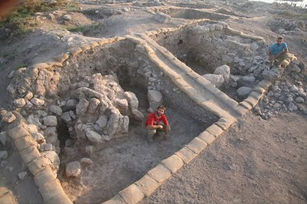2012 Excavation Results
The tenth large-scale excavation season at Megiddo was carried out over a seven week period in June and July 2012, with over 100 staff and team members participating. Four areas were dug: Areas H, K, Q, which were also excavated in 2010 and in previous seasons, and Area S, which was opened this season.
Area H
Excavation continued in this stratigraphic trench, located in the northwestern sector of the mound, near the complex of palaces, which had been unearthed in the 1930s by the University of Chicago team. In 2012 it became clear that Level H-11, uncovered in 2010, equals University of Chicago Stratum VIIA of the Late Bronze III – the final Late Bronze layer at Megiddo. Excavations in 2012 shed important light on the material culture, date and history of this city. Radiocarbon results put the destruction of Level H-11 in the late 12th century BCE. Earlier levels, which date to the Late Bronze II, were unearthed in 2012.
Area K
The exposure of Level K-9 has been concluded and work continued on Levels K-10 of the Late Bronze I and K-11 of the end-phase of the Middle Bronze. The nature of the transition from the Middle Bronze to the Late Bronze at Megiddo had been under dispute. It is now clear that at least in Area K this transition was peaceful; there were no signs of destruction. Excavation of the Middle Bronze brick and earth fortifications continued. The city-wall is over six meters wide and is preserved to a height of over three meters. An earthen glacis supported the city-wall on its outer side.
General aerial photograph of Area K, with elements of Levels K-9 and K-10; note brick Middle Bronze city-wall at left end of the area
Area Q
The main achievement of the 2012 season was the excavation of a large Iron IIA building, which features three rows of six pillars each – apparently 18 pillars in all. When the building went out of use, part of its space was given over to iron working. In another sector of the area excavation reached the destruction layer of the late Iron I. A geo-archaeological study of this layer began during the season and will continue in an additional short season here in October 2012. A hoard of six iron daggers and two bronze bowls, dating to the Iron I, was discovered in the southern part of the area.
Aerial photograph of the northern sector of Area Q, with remains of Iron IIA pillared building (to the right of the group of team members)
Area S
Excavation here was conducted in Area AA of the University of Chicago dig. The goal was to shed light on the Middle Bronze fortifications, including the well-known gate of Stratum XIII – the earliest gate exposed to date at Megiddo. The dig exposed the different phases of the Middle Bronze fortifications and revealed that the gate as described following the 1930s excavation does not exist. The true gate, which belongs to the early phase of the Middle Bronze Age, has a different plan. It was blocked in a later phase of the period. A large Middle Bronze tower was unearthed under the Late Bronze gate plaza.
Several micro-archaeology projects were undertaken at Megiddo during the 2012 season. These included geo-archaeological, paleo-magnetism and metallurgical investigations in Area Q and a continuing effort to radiocarbon date the many layers in the two stratigraphic sections – Areas H and K.







